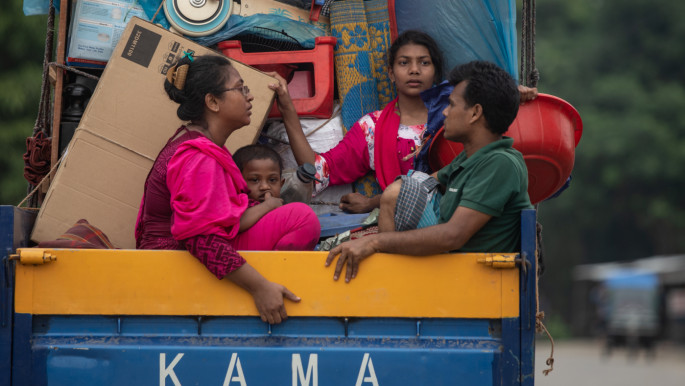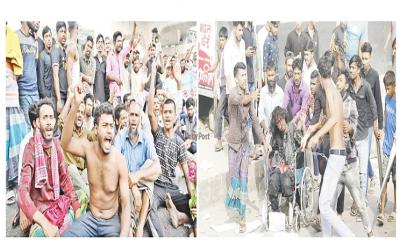-From 2022 to 2023, migration to cities declined to 19.6 ppl in thousand
-Price hike is a major cause of leaving
- Air, water, sound pollution demotivates to dwell
-Villages turns to city day by day with modern amenities
- Educated becomes entrepreneur based on locality
Migration from villages to cities in the hope of a better life is nothing new. Villagers have to come to the city for various reasons including education, job, treatment. Many people left the village and settled in the city. As a result, the number of people coming from the villages to the cities is increasing all the time due to various reasons. During the Corona pandemic, that number decreased slightly, but later it increased again. But last year there was a big change in the number of people coming from villages to cities.
According to a report by Bangladesh Bureau of Statistics (BBS), the number of people leaving the city for rural areas has more than doubled in two years. In 2021, 5.9 people out of every thousand moved from urban to rural areas and in 2023 the number increased to 13.8.
Bangladesh Sample Vital Statistics-2023 report published by BBS in the last month of March, these data about immigration have emerged. BBS conducted a survey of 3 lakh 8 thousand 32 households to prepare the report. According to the report, the number of people coming from the village to the city has decreased by about 7 people per thousand. In 2019, 15 people migrated from rural to urban areas (per thousand population), in 2020 it decreased to 12.7 people due to the corona epidemic. In 2021, the number increased again to 18.4 people, in 2022, the number increased to 26.4 people. However, from 2022 to 2023, the number of people coming from villages to cities has decreased to 19.6 people.
On the other hand, the number of people leaving cities for rural areas has more than doubled in two years. During the corona epidemic, the tendency of people to move from cities to villages increased. Although the Corona situation is normal, the tendency of people to leave the city has not decreased, but the tendency to leave the city and return to the village is increasing year by year due to socio-economic reasons. According to the BBS report, in 2021, 5.9 out of every 1,000 people moved from urban to rural areas. In 2023, this number increased to 13.8 people. This number was 0.7 people respectively in 2019 and increased to 8.4 people in 2020 due to the impact of Corona epidemic. In 2022, this number was 10.9 people.
There are various logical reasons behind why the number of people coming from rural to urban areas has decreased from 2022 to 2023 and the number of people returning from urban to rural areas has increased. Experts said expenses are more than income. It is becoming difficult to live with a family in Dhaka due to rising commodity prices. Children's education costs have increased, house rents are increasing every year. Monthly expenditure cannot be kept in line with income.
the reason for the decrease in the number of people coming from the village to the city is that, in this period of rising commodity prices, life can be more comfortable in the village than in the city. Moreover, educated unemployed youths are becoming entrepreneurs instead of chasing jobs in the city. They are again giving the people of the village various jobs. Besides, villages are gradually turning into cities. Various amenities of the city have now reached the village. Various facilities of the city can be enjoyed easily from the village. Moreover, the standard of living in the city has now become difficult due to the rising cost of goods. Mainly due to these reasons, the number of people coming from villages to cities has decreased.
Regarding the decrease in the number of people coming from villages to cities, an entrepreneur named Abdul Momen said that people come from villages to cities for a little improvement in the quality of life. After completing Honors-Masters, I myself moved from village to city. I have moved from the city to the village again. In 2022, I came to the village and thought about doing something myself. Now busy with cow farm, fish farming, vegetable farming. I have six more people to take care of my cow farm, fish enclosures. The bottom line is that if I did not do these things in the village, those who work in my firm would have moved to Dhaka in search of jobs.But now the income in the village can go quite comfortably.
Firoz Ahmed, who had just graduated, wanted to come from the village to the city for work. But now he has decided to do something not in the city but in the village. Regarding not going from village to city, he said, his father and grandfather have a house here, they can eat a little by farming. No house rent required. You have to buy water in the city. If you buy rice in the village, curry is available from here and there. Fish can be caught in rivers and ponds with spears. Village people do not have to buy chickens, they raise them themselves, and sometimes someone sells them. In the city one has to pay the gas bill or buy gas in a cylinder to cook but in the village one can cook with leaves and vines in a mud stove. Electricity, air, gas and water have to be bought in the city. But in the village at least these things do not cost anything.
Gazi Faruq who left the capital with his family to the village of Chadpur. He said that "My expenses increased." On top of that, I was struggling to manage my family properly due to the increase in commodity prices. Meanwhile, house rent has also increased. All in all, it was not possible to survive in Dhaka. So I went to the village house.
Zamal Afsari, a private employee of the capital, said that many people are leaving Dhaka due to changing professions. He said, no one comes to the city suddenly and leaves again suddenly. Some people change professions many times according to the season — driving rickshaws, doing different kinds of work. Sell something on the sidewalk. Then when it's not happening then leave the city. Others lived with their families. Seeing that it is not possible to stay with the family after Corona, the wife and children are sent to the village and stay in a small room or mess, but this is always happening.
Mentioning river erosion as one of the reasons for moving from village to city or from village to another village, he further said that many people lost their houses due to river erosion and moved to city slums. Come to the city and work in garments or do small things to earn a living. It happens in many cases - there was a name in the family but it has been sold by generation, in the village it is no longer possible to eat by begging or begging - people will recognize or say bad things. That is why he left the village and went elsewhere.
Ghulam Rahman, president of Consumers Association of Bangladesh (CAB), said that the decrease in the number of people coming from villages to cities is positive. He said, many facilities have been created in the village now. Many things in the city are available in the village. Moreover, after hearing about the sufferings of the city from the neighbors, the interest in coming to the city has decreased. The standard of living in the city is not what it used to be. It has become very difficult. So people are now less inclined to come to the city.
Mostafizur Rahman, a fellow at the Center for Policy Dialogue (CPD), said that the number of people returning from cities to villages and the number of people coming from villages to cities is decreasing. Generally, such internal migration usually increases in places where relative opportunities are created. Here one is the push factor and the other is the pull factor. Sometimes the opposite is also the case. When costs rise in a place and someone is forced to move out of that place — that's a push factor. And when someone comes to the city for opportunity, for improved quality of life — that's the pull factor. It draws people to the city. As there are fewer opportunities in rural areas than in cities, people migrate from villages to cities. The push factor works only when the reverse is the case. A push factor operates when spending is higher than income when inflation occurs. Low-income people in the city are now finding it difficult to match their expenditure with their income. The cost of living — food and non-food — has now risen more than income. That's why people are leaving the city and moving to the village.
On the other hand, regarding the decrease in the number of people coming from villages to cities, he said, agricultural wages are increasing, the income of productive people involved in agricultural work is increasing. It is a question whether that phenomenon makes some people village-based. Again, since villages are cities, various opportunities are being created in the sub-cities, and it is also to be seen whether those things encourage people to stay in the villages. But I think this trend is not active yet. Basically the push factor is working. Due to rising costs, people move from cities to villages and stay there because the costs there are relatively affordable.
ZH






